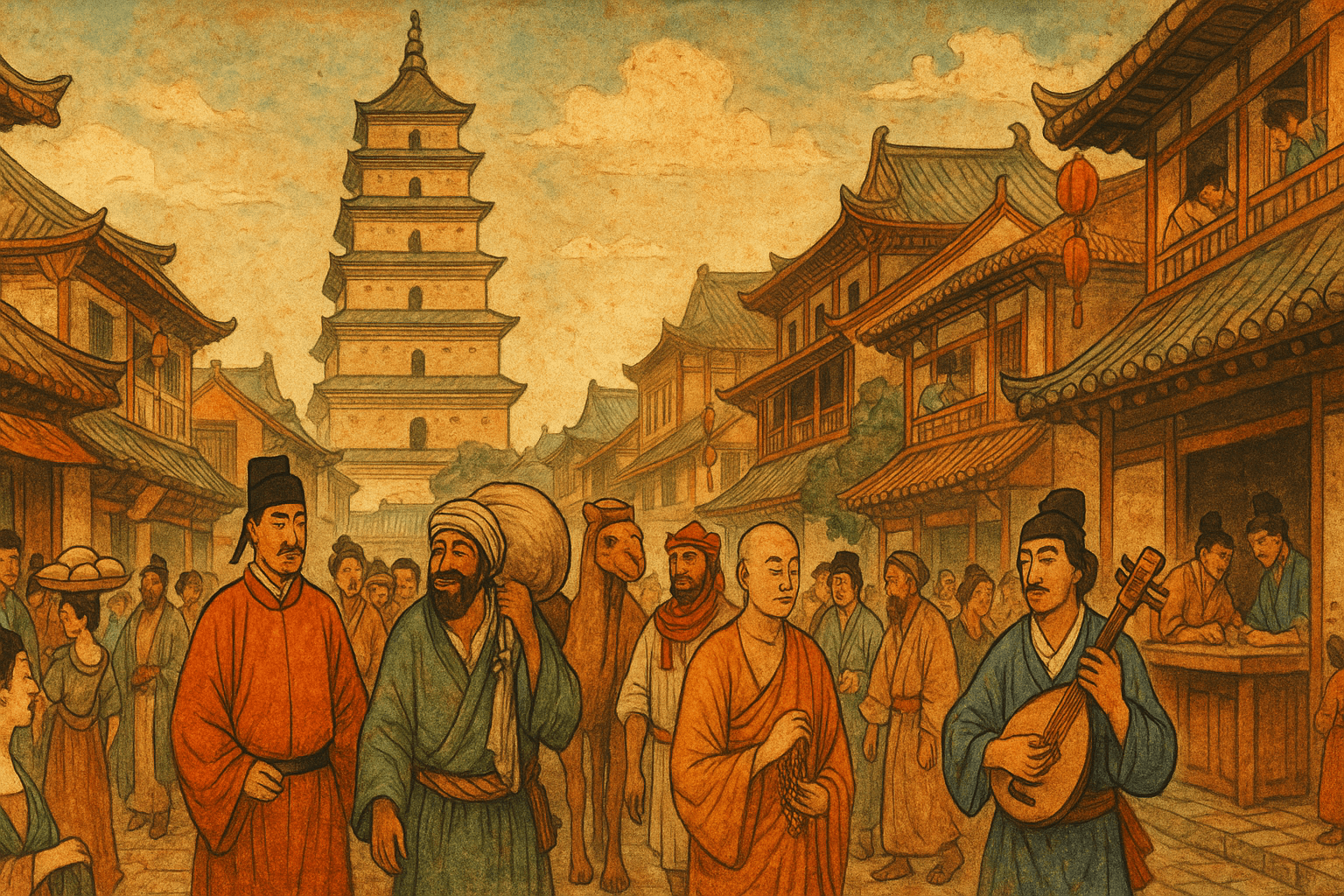Forging an Empire of Gold
The Tang Dynasty rose from the ashes of the short-lived but foundational Sui Dynasty. The Sui had reunified China after centuries of division and laid crucial groundwork, such as constructing the Grand Canal. It was, however, the Tang’s founding emperors, particularly the brilliant and formidable Emperor Taizong (r. 626-649 AD), who ushered in an era of stability, prosperity, and effective governance. Through a combination of military prowess, diplomatic skill, and administrative reform, Taizong established a secure and prosperous empire. He expanded the civil service examination system, creating a path for talented men from various social strata to enter government, fostering a more meritocratic bureaucracy that would become a hallmark of Chinese governance for centuries.
Chang’an: The Center of the World
At the apex of this flourishing empire was its capital, Chang’an (modern-day Xi’an). Meticulously planned on a vast grid system, it was the largest and most populous city on Earth. Enclosed by massive rammed-earth walls, the city was a stunning display of imperial power and urban planning. Its population, including the sprawling suburbs, exceeded one million people—a staggering figure for the pre-industrial world.
What truly defined Chang’an was its cosmopolitan character. It was the eastern terminus of the Silk Road, and its two massive, state-regulated markets—the West Market and the East Market—were a microcosm of the known world. Here, you could find:
- Goods: Silks, porcelains, and tea from China; powerful warhorses from the steppes; spices and gems from India and Southeast Asia; glassware from Persia; and furs from the north.
– People: Sogdian and Persian merchants who dominated much of the Silk Road trade, Japanese and Korean students and monks seeking knowledge, Turkic warriors serving in the Tang armies, and Nestorian Christians, Zoroastrians, and Manichaeans who established places of worship alongside Buddhist and Daoist temples.
This wasn’t just tolerance; it was an active and curious engagement with the outside world. Foreign music, fashion, and even sports like polo (introduced from Persia) became wildly popular among the Tang elite. The city was a melting pot where ideas, technologies, and cultures mixed freely, fueling innovation and a uniquely vibrant atmosphere.
The Silk Road Reborn and Maritime Trade
While the Silk Road had existed for centuries, it reached its zenith under the Tang. The dynasty’s powerful armies pacified the long and dangerous trade routes through Central Asia, making travel safer and more reliable. This security unleashed a torrent of commercial and cultural exchange. Caravans of camels traversed deserts and mountains, linking China directly with Central Asia, India, and the Middle East.
Simultaneously, maritime trade routes were expanding. Bustling port cities like Guangzhou (Canton) in the south hosted large communities of foreign traders. Sea lanes connected China to Southeast Asia, the Indian Ocean, and the Persian Gulf, creating a truly globalized economy for its time. Tea, a beverage popularized during the Tang, began its journey to becoming a global commodity, while Chinese ceramics, especially the famous tri-color glazed pottery (sancai), were exported far and wide, with shards still being found in archaeological sites across Asia and the African coast.
A Renaissance of Poetry and Art
The wealth and stability of the Tang Golden Age fostered one of the most brilliant cultural flowerings in human history. This was, above all, the age of poetry. Poems were a part of everyday life, written by emperors, officials, monks, and courtesans. The era produced arguably China’s two greatest poets: Li Bai and Du Fu.
- Li Bai (701-762): Known as the “Poet Immortal”, Li Bai was a romantic, a Daoist wanderer whose verses are filled with powerful imagery, a love of nature, and a celebration of wine and freedom. His poetry is bold, imaginative, and expresses a sense of untamable spirit.
– Du Fu (712-770): A stark contrast, Du Fu is the “Poet Sage.” A Confucian moralist, his work is marked by technical brilliance, social commentary, and deep compassion for the suffering of the common people, especially during times of war and upheaval.
Beyond poetry, the other arts thrived. Landscape painting (shan shui, “mountain-water”) matured into a sophisticated art form, conveying Daoist ideals of harmony between humanity and the natural world. Calligraphy was held in the highest esteem, seen as a reflection of a person’s character and spirit. Music and dance absorbed foreign influences, creating new and exciting styles performed at the imperial court and in the taverns of Chang’an.
The Shadow of Rebellion and the End of an Era
No golden age lasts forever. The turning point for the Tang Dynasty was the devastating An Lushan Rebellion (755-763 AD). An Lushan, a powerful general of non-Han Chinese descent, rose in rebellion against the throne, plunging the empire into a brutal civil war. Though the Tang Dynasty ultimately survived, it was a shadow of its former self. The rebellion shattered the central government’s authority, devastated the population, and allowed regional military governors to gain unprecedented power, effectively fragmenting the empire.
The cosmopolitan openness and confidence of the early and high Tang slowly gave way to a more insular and xenophobic attitude. The final century and a half of the dynasty was marked by political instability, eunuch interference in court politics, and peasant uprisings, culminating in its official collapse in 907 AD.
The Legacy of a Golden Age
Despite its tumultuous end, the Tang Dynasty’s golden age remains a high-water mark in Chinese civilization. It established patterns in governance, culture, and international relations that would influence all subsequent dynasties. Its poetry is still memorized by schoolchildren, its art is treasured in museums worldwide, and its legacy of cosmopolitanism and cultural brilliance continues to inspire. The Tang represents a time when China was arguably the most powerful, most prosperous, and most culturally dynamic nation on Earth—a true golden age that set a benchmark for civilization.
